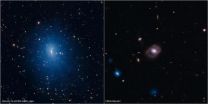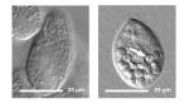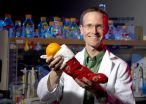(Press-News.org) A new study from NASA's Chandra X-ray Observatory tells scientists how often the biggest black holes have been active over the last few billion years. This discovery clarifies how supermassive black holes grow and could have implications for how the giant black hole at the center of the Milky Way will behave in the future.
Most galaxies, including our own, are thought to contain supermassive black holes at their centers, with masses ranging from millions to billions of times the mass of the Sun. For reasons not entirely understood, astronomers have found that these black holes exhibit a wide variety of activity levels: from dormant to just lethargic to practically hyper.
The most lively supermassive black holes produce what are called "active galactic nuclei," or AGN, by pulling in large quantities of gas. This gas is heated as it falls in and glows brightly in X-ray light.
"We've found that only about one percent of galaxies with masses similar to the Milky Way contain supermassive black holes in their most active phase," said Daryl Haggard of the University of Washington in Seattle, WA, and Northwestern University in Evanston, IL, who led the study. "Trying to figure out how many of these black holes are active at any time is important for understanding how black holes grow within galaxies and how this growth is affected by their environment."
This study involves a survey called the Chandra Multiwavelength Project, or ChaMP, which covers 30 square degrees on the sky, the largest sky area of any Chandra survey to date. Combining Chandra's X-ray images with optical images from the Sloan Digital Sky Survey, about 100,000 galaxies were analyzed. Out of those, about 1,600 were X-ray bright, signaling possible AGN activity.
Only galaxies out to 1.6 billion light years from Earth could be meaningfully compared to the Milky Way, although galaxies as far away as 6.3 billion light years were also studied. Primarily isolated or "field" galaxies were included, not galaxies in clusters or groups.
"This is the first direct determination of the fraction of field galaxies in the local Universe that contain active supermassive black holes," said co-author Paul Green of the Harvard-Smithsonian Center for Astrophysics in Cambridge, MA. "We want to know how often these giant black holes flare up, since that's when they go through a major growth spurt."
A key goal of astronomers is to understand how AGN activity has affected the growth of galaxies. A striking correlation between the mass of the giant black holes and the mass of the central regions of their host galaxy suggests that the growth of supermassive black holes and their host galaxies are strongly linked. Determining the AGN fraction in the local Universe is crucial for helping to model this parallel growth.
One result from this study is that the fraction of galaxies containing AGN depends on the mass of the galaxy. The most massive galaxies are the most likely to host AGN, whereas galaxies that are only about a tenth as massive as the Milky Way have about a ten times smaller chance of containing an AGN.
Another result is that a gradual decrease in the AGN fraction is seen with cosmic time since the Big Bang, confirming work done by others. This implies that either the fuel supply or the fueling mechanism for the black holes is changing with time.
The study also has important implications for understanding how the neighborhoods of galaxies affects the growth of their black holes, because the AGN fraction for field galaxies was found to be indistinguishable from that for galaxies in dense clusters.
"It seems that really active black holes are rare but not antisocial," said
Haggard. "This has been a surprise to some, but might provide important clues about how the environment affects black hole growth."
It is possible that the AGN fraction has been evolving with cosmic time in both clusters and in the field, but at different rates. If the AGN fraction in clusters started out higher than for field galaxies -- as some results have hinted -- but then decreased more rapidly, at some point the cluster fraction would be about equal to the field fraction. This may explain what is being seen in the local Universe.
The Milky Way contains a supermassive black hole known as Sagittarius A* (Sgr A*, for short). Even though astronomers have witnessed some activity from Sgr A* using Chandra and other telescopes over the years, it has been at a very low level. If the Milky Way follows the trends seen in the ChaMP survey, Sgr A* should be about a billion times brighter in X-rays for roughly 1% of the remaining lifetime of the Sun. Such activity is likely to have been much more common in the distant past.
If Sgr A* did become an AGN it wouldn't be a threat to life here on Earth, but it would give a spectacular show at X-ray and radio wavelengths. However, any planets that are much closer to the center of the Galaxy, or directly in the line of fire, would receive large and potentially damaging amounts of radiation.
INFORMATION:
These results were published in the November 10th issue of the Astrophysical Journal. Other co-authors on the paper were Scott Anderson of the University of Washington, Anca Constantin from James Madison University, Tom Aldcroft and Dong-Woo Kim from Harvard-Smithsonian Center for Astrophysics and Wayne Barkhouse from the University of North Dakota.
NASA's Marshall Space Flight Center in Huntsville, Ala., manages the Chandra program for NASA's Science Mission Directorate in Washington. The Smithsonian Astrophysical Observatory controls Chandra's science and flight operations from Cambridge, Mass.
How often do giant black holes become hyperactive?
2010-12-21
ELSE PRESS RELEASES FROM THIS DATE:
New study upends thinking about how liver disease develops
2010-12-21
In the latest of a series of related papers, researchers at the University of California, San Diego School of Medicine, with colleagues in Austria and elsewhere, present a new and more definitive explanation of how fibrotic cells form, multiply and eventually destroy the human liver, resulting in cirrhosis. In doing so, the findings upend the standing of a long-presumed marker for multiple fibrotic diseases and reveal the existence of a previously unknown kind of inflammatory white blood cell.
The results are published in this week's early online edition of the Proceedings ...
UCSB scientists demonstrate biomagnification of nanomaterials in simple food chain
2010-12-21
(Santa Barbara, Calif.) –– An interdisciplinary team of researchers at UC Santa Barbara has produced a groundbreaking study of how nanoparticles are able to biomagnify in a simple microbial food chain.
"This was a simple scientific curiosity," said Patricia Holden, professor in UCSB's Bren School of Environmental Science & Management and the corresponding author of the study, published in an early online edition of the journal Nature Nanotechnology. "But it is also of great importance to this new field of looking at the interface of nanotechnology and the environment."
Holden's ...
New imaging advance illuminates immune response in breathing lung
2010-12-21
Fast-moving objects create blurry images in photography, and the same challenge exists when scientists observe cellular interactions within tissues constantly in motion, such as the breathing lung. In a recent UCSF-led study in mice, researchers developed a method to stabilize living lung tissue for imaging without disrupting the normal function of the organ. The method allowed the team to observe, for the first time, both the live interaction of living cells in the context of their environment and the unfolding of events in the immune response to lung injury.
The finding ...
Strange new twist: Berkeley researchers discover Möbius symmetry in metamaterials
2010-12-21
Möbius symmetry, the topological phenomenon that yields a
half-twisted strip with two surfaces but only one side, has been a source of fascination since its discovery in 1858 by German mathematician August Möbius. As artist M.C. Escher so vividly demonstrated in his "parade of ants," it is possible to traverse the "inside" and "outside" surfaces of a Möbius strip without crossing over an edge. For years, scientists have been searching for an example of Möbius symmetry in natural materials without any success. Now a team of scientists has discovered Möbius symmetry in ...
New study examines immunity in emerging species of a major mosquito carrer of malaria
2010-12-21
In notable back-to-back papers appearing in the prestigioous journal Science in October, teams of researchers, one led by Nora Besansky, a professor of biological sciences and a member of the Eck Institute for Global Health at the University of Notre Dame, provided evidence that Anopheles gambiae, which is one of the major mosquito carriers of the malaria parasite in Sub-Saharan Africa, is evolving into two separate species with different traits.
Another significant study appearing in this week's edition of the Proceedings of the National Academy of Sciences (PNAS) and ...
New study focuses on nitrogen in waterways as cause of nitrous oxide in the atmosphere
2010-12-21
Jake Beaulieu, a postdoctoral researcher the Environmental Protection Agency in Cincinnati, Ohio, who earned his doctorate at the University of Notre Dame, and Jennifer Tank, Galla Professor of Biological Sciences at the University, are lead authors of new paper demonstrating that streams and rivers receiving nitrogen inputs from urban and agricultural land uses are a significant source of nitrous oxide to the atmosphere.
Nitrous oxide is a potent greenhouse gas that contributes to climate change and the loss of the protective ozone layer. Nitrogen loading to river networks ...
The orange in your stocking: researchers squeezing out maximum health benefits
2010-12-21
VIDEO:
BYU nutritionist Tory Parker talks about his study into why oranges are so good for you.
Click here for more information.
Provo, Utah - In time for Christmas, BYU nutritionists are squeezing all the healthy compounds out of oranges to find just the right mixture responsible for their age-old health benefits.
The popular stocking stuffer is known for its vitamin C and blood-protecting antioxidants, but researchers wanted to learn why a whole orange is better for ...
Link between depression and inflammatory response found in mice
2010-12-21
Vanderbilt University researchers may have found a clue to the blues that can come with the flu – depression may be triggered by the same mechanisms that enable the immune system to respond to infection.
In a study in the December issue of Neuropsychopharmacology, Chong-Bin Zhu, M.D., Ph.D., Randy Blakely, Ph.D., William Hewlett, M.D., Ph.D., and colleagues activated the immune system in mice to produce "despair-like" behavior that has similarities to depression in humans.
"Many people exhibit signs of lethargy and depressed mood during flu-like illnesses," said Blakely, ...
Boosting supply of key brain chemical reduces fatigue in mice
2010-12-21
Researchers at Vanderbilt University have "engineered" a mouse that can run on a treadmill twice as long as a normal mouse by increasing its supply of acetylcholine, the neurotransmitter essential for muscle contraction.
The finding, reported this month in the journal Neuroscience, could lead to new treatments for neuromuscular disorders such as myasthenia gravis, which occurs when cholinergic nerve signals fail to reach the muscles, said Randy Blakely, Ph.D., director of the Vanderbilt Center for Molecular Neuroscience.
Blakely and his colleagues inserted a gene into ...
Dodds contributes to new national study on nitrogen water pollution
2010-12-21
MANHATTAN, KAN. -- A Kansas State University professor is part of a national research team that discovered that streams and rivers produce three times more greenhouse gas emissions than estimated by the Intergovernmental Panel on Climate Change.
Through his work on the Konza Prairie Biological Station and other local streams, Walter Dodds, university distinguished professor of biology, helped demonstrate that nitrous oxide emissions from rivers and streams make up at least 10 percent of human-caused nitrous oxide emissions -- three times greater than current estimates ...




